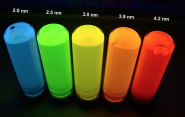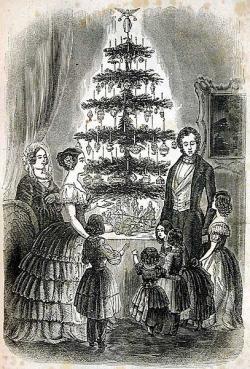Quantum Dots: The Lights of Christmas Future

It was in the 1880s, not long after Thomas Edison produced the first lightbulb, that we had the first electrically illuminated Christmas tree (in the home of an Edison associate). Due to costs and availablilty of electricity, Christmas tree lights wouldn't become a common sight for many years after that.
 Light bulbs were a huge leap from the picturesque - and very dangerous - candle-lit trees. And a lot has changed since the bulky incandescent bulbs that reigned for decades as the dominant tree-lighting technology. A big part of that change has to do with light-emitting diodes (LEDs). More vivid and a lot more efficient, they've increasingly become the light of choice on trees. And LED lights have since improved in recent years, thanks to quantum dots - very small semiconductor nanocrystals that can be engineered to deliver a warmer light with vibrant colors. The colors emitted are determined by the size of the quantum dot, which is tunable. Already more efficient than incandescent bulbs, which burn most of their energy though heat, LEDs save even more energy with the help of quantum dots.
Light bulbs were a huge leap from the picturesque - and very dangerous - candle-lit trees. And a lot has changed since the bulky incandescent bulbs that reigned for decades as the dominant tree-lighting technology. A big part of that change has to do with light-emitting diodes (LEDs). More vivid and a lot more efficient, they've increasingly become the light of choice on trees. And LED lights have since improved in recent years, thanks to quantum dots - very small semiconductor nanocrystals that can be engineered to deliver a warmer light with vibrant colors. The colors emitted are determined by the size of the quantum dot, which is tunable. Already more efficient than incandescent bulbs, which burn most of their energy though heat, LEDs save even more energy with the help of quantum dots.
"By putting quantum dots into them, people have boosted the efficiency," said Prof. Mark Reed, who coined the term "quantum dots" in the 1980s, when he was doing research on their electronic applications. "What it does is now you have these low–power LEDs which get not just white light, but can do green light, blue light, red light – you can get all the Christmas colors you want out of them. Now, being able to do it very compactly means that the Christmas lights you put on your tree don't have to be strings of these light bulbs, but can be these tiny little LEDs."
The technology has the potential for applications well beyond decorative lighting. Because it covers a greater range of the color spectrum, technology experts say it could mark a major improvement in displays for computer monitors and televisions.
Industry was at first slow to jump on the potential of quantum dots, so most of the initial research on them was done in academia. That's because little was known in the 1980s about gallium nitride, the semiconductor material that produces the blue necessary to create the broad spectrum of light.
 Reed has since moved on to working on other small systems, but is glad that he was on the groundfloor of a technology that's just now becoming widely known.
Reed has since moved on to working on other small systems, but is glad that he was on the groundfloor of a technology that's just now becoming widely known.
"It was a real revolution," said Reed, the Harold Hodgkinson Professor of Electrical Engineering for Yale SEAS. "We were laying the groundwork of understanding how these things worked, which really has had tremendous impact in energy efficiency for lighting. So lighting is a huge amount of our electrical consumption, and everything we can do to increase the efficiency is going to save billions of barrels of oil."
So how did Reed come up with the term "quantum dots"?
"When we were first working on these, no one had a good name," he said. "And then all of a sudden, it was just some Friday afternoon, it was, 'Hey, quantum dots!' That's how we came up with that term."

